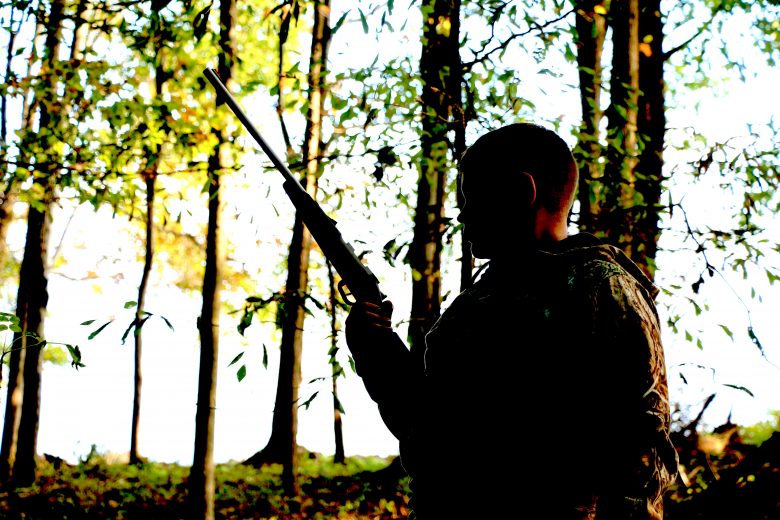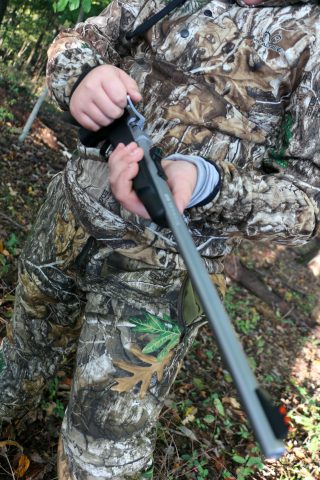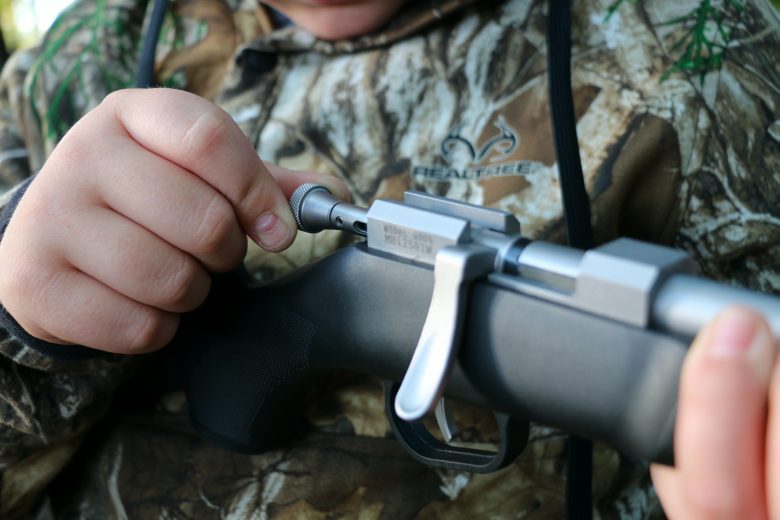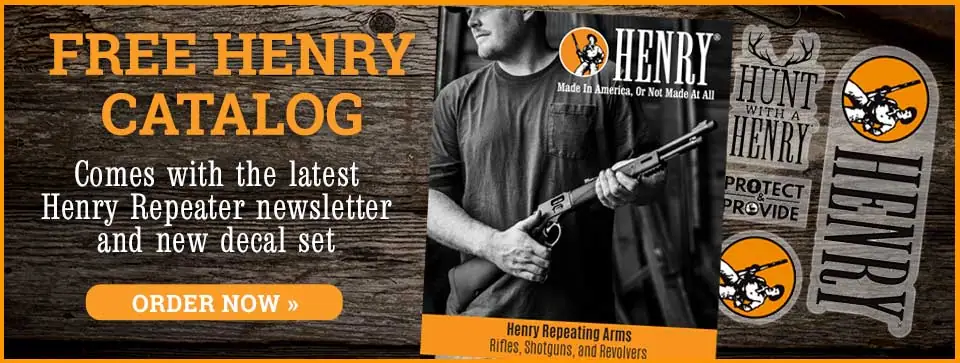Small Game Hunting with Youth Model Guns
Your guide for hunting small game with youth model guns
Youth hunting is one of the most important aspects of keeping our hunting heritage alive. If we don’t pass it on to the next generation of hunters, it won’t be long before hunting is a thing of the past. It’s our responsibility to ensure this way of life continues for decades to come. Here is your guide for small game hunting with youth model guns.

Small game hunting is a great way to introduce youth to the outdoors. (Honeycutt Creative photo)
Small Game and Youth Hunting

A safe, reliable rimfire weapon, such as the Henry Mini Bolt Youth, is the perfect firearm to introduce kids to squirrel hunting. (Honeycutt Creative photo)
In the early to mid-1900s, the big game was largely shot out with low population densities. Because of that, small game hunting reigned supreme. Hunters throughout the nation spent a lot of time chasing rabbits, squirrels, and other small game.
Modern hunting has seen a major resurgence in big game pursuits. Today, elk, mule deer, whitetails, and even turkeys are the dominant game species, but especially whitetails. As a result, small game hunting has seen a major decline in participation. That’s a shame, too, because small game hunting is excellent for all ages, including youth hunters.
In fact, small game hunting is arguably the best option for introducing kids to the outdoors. This is true for several reasons. First, it provides an opportunity to experience God’s creation. What better way to see what nature has to offer than in a dove field, rabbit patch, or squirrel woods?
Secondly, it gives young hunters constant action. Big game hunting is notorious for long periods of inactivity followed by rapid, short-lived action. Both the lows and highs can prove too much for youth hunters. In contrast, small game hunting is more constant and even-toned. This is good for both new and young hunters alike.
Third, after taking and passing hunter’s education courses, small game hunting is the next step in learning safe gun handling and shooting. Learning to unload guns before crossing barriers, such as fences, taking ethical shots, and more, start in the classroom. These are reinforced and engrained in the field.
It even serves as an excellent way to reinforce mental strength and shooting skills. For most, big game produces a higher level of adrenaline than smaller animals, which makes it an excellent training tool for managing emotions and composure under pressure. Then, after becoming familiar with small game, they can move on to bigger challenges.
And finally, small game hunting is fun in its own right. It isn’t merely for the young or inexperienced. It’s a lifelong tradition of its own. And that’s the No. 1 reason to take youth hunters on small game adventures, which leads us to options.
The Best Youth Hunts
There are many different small game species available to American hunters. Depending on location, hunters have access to a good number of game species. Of course, habitat variety and terrain features have an impact.
One of the most common options is doves. These exist throughout much of the country, and youth hunters can experience what this has to offer. It’s an excellent wing shooting challenge, and a way for hunters to learn how to shoot at moving targets. Pigeons offer the same.
Speaking of avian species, upland birds, such as quail, pheasant, and grouse, are certainly viable for those who hunt in such strongholds and who have the dogs necessary to chase them. These too are great ways to get hunters into the outdoors.
Sticking to the shotgun theme, rabbits offer a unique experience. Young and old hunters alike enjoy the sounds of a beagle hound hot on the heels of a fuzzy cottontail. Getting a shot at a rabbit is a bonus.
Similarly, squirrel dogs make it fun to hunt bushytails. But dog or no dog, these offer excellent small game hunting opportunities for kids. Whether using a shotgun, or a rimfire rifle, it teaches valuable lessons for young hunters.
Looking strictly to rimfire hunting, few hunts offer more action than prairie dogs. For those who have access to this type of hunting, it’s the best hunt for improving shooting skills and shot selection ethics.
Lastly, coyotes are great, too. Like big game, it produces periods of inactivity followed by rapid action, but it (along with turkey hunting) is the perfect bridge from small game hunting to bigger game, such as deer.
Other small game adventures exist as well, such as bullfrogs (some states allow hunting with a rimfire rifle), groundhogs, raccoons, and other small- to medium-sized game.
Small Game Hunting Tips
Hunting small game requires a knowledge base and skill set to be successful. In that way, it’s no different than big game. Of course, the first thing a youth hunter should do is complete a hunter education course. That lays the foundation. Then, the adult who plans to take them can build on that base.
It’s also important to ensure youth hunters wear the proper clothing. You must keep them warm (when cold) and cool (when hot) or they’re less likely to go the next time. Generally, they need multiple trips afield for them to stick with it, and a bad first outing can prevent that. And if they feel as if they don’t have the right clothing and gear for the activity at hand, they might feel shortchanged or out of place. Keep them mentally in the game.
Next, know the game you’re after. Hunting is hunting. It doesn’t always involve a kill. But if you do your job well, kids will at least have fun. Getting to see wild game is a win, and will likely spark a great interest for a return trip. And at the very least, if the hunt itself doesn’t pan out, at least make it a fun experience. Entertain the kids, keep them engaged, but also know when it’s time to quit. Staying too long is not a good thing.
Be a mentor. Use hunting as an opportunity to teach kids, too. Help them understand what makes animals tick. Teach them their biology and tendencies, as well as how to hunt them. Hunting is more about learning than anything else.
Have trouble putting youth hunters in the action? Hunt edge cover — ground-based small game, such as rabbits, thrive in such places. In contrast, if hunting squirrels, look for more mature timber with plenty of hard masts, such as acorns and hickory nuts. All things considered, if you find the food, water, and cover, you’ll find the critters.
If you’re still having trouble finding squirrels, it might just be a bad day for movement. Start glassing for dangling tails, or pack it up and return another time when the odds are higher. It’s also good to use small game hunting dogs, which can help stir things up when the action is slow. Kick up something to shoot at.
If the action is hot, but your youth hunter is having a hard time getting shots off, teach them how to get on target quickly and efficiently. Finding game in the sights is a learned skill and not one you can master in a classroom or in one outing. It takes time and experience.

This simple yet effective design is the perfect small game gun for youth hunters. (Honeycutt Creative photo)
Small Game Recovery Tips
Just as with any type of hunting, sometimes it’s difficult to recover downed game, especially with subpar shots. You won’t find every animal. But you should always do your best to recover dead and wounded game, and you should stress this ethical truth to the youth hunters under your watch. They’ll learn their ethics from you. Think about that. It’s powerful.
But if your youth hunter gets a shot off, there are certain steps to take. Before moving, mark where you shot from, and mark the last known location of the animal. If possible, have someone stand at the shot location while the primary adult guide searches.
Also, look for blood, hair, and feathers at the shot of impact and in the surrounding area. Sometimes, small game can make it a fair distance before dying, and you might even follow blood or other sign to its final resting place.
If you still can’t find downed game, remember to look in tight spots. Animals might make it into such areas before dying. They might also still be alive, and a follow-up shot is needed. This too is an important lesson youth hunters eventually learn. And if you just can’t find dead or wounded game, use a dog. They have a much better nose than you.
If you are fortunate enough to bag something and recover it, know how to properly (and tastefully) clean the animal for the kid. Don’t make it a gory mess. But don’t hide the fact that you’re taking a life and that the animal’s life is meant to sustain yours, too. Hunting is hunting, which involves killing. We should never hide or be ashamed of that. But we shouldn’t boastfully project it in an obnoxious manner, either.
Finally, have patience. Taking kids hunting isn’t easy. It’s a process and a long one. Don’t get discouraged. Stay positive. Do everything in your power to make it the best day of that kid’s life.
Great Youth Guns for the Job
Henry recognizes the importance of getting our youth into the outdoors, and those who plan to take a youth hunting should pair them with a safe, proven youth model gun they can rely on. While Henry has a complete line of youth rifles and shotguns, three options stand out.

First is the Henry Mini Bolt Youth. Chambered in .22 S/L/LR, it’s the premier youth rifle for introducing kids to shooting and small game hunting. While its overall length is 30.25 inches, its length of pull is only 11.5 inches. Also, it has a 16.25-inch, round stainless barrel with a 1:16 rate of twist. The gun’s overall weight is 3.25 pounds. It sports fiber optic front and rear sights, but it’s also drilled and tapped for scopeability. It includes a thumb-style safety. It comes in black, instant orange, or Muddy Girl camo.

Next up is the Henry Lever Action .22 Youth. This gun is compact, lightweight, and ideal for youth hunters. It weighs 4.5 pounds, has a 13-inch length of pull, and a 33-inch overall length. The barrel length is 16.125 inches, has a rate twist of 1:16, and a round blued steel barrel type.

Finally, for those hunts where you just need a good, trusty shotgun, try the Henry Single Shot Youth Shotgun. It’s the perfect starter shotgun for kids. This 20-gauge is built for performance. It has a 26-inch, round blued steel barrel. The overall length is 40.5 inches, the length of pull is 13 inches, and weighs 6.74 pounds. It has a brass bead in the front for easy aiming.
Other models are available, too.All are made in America, as they should be.






